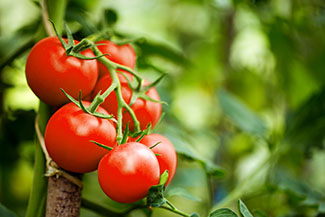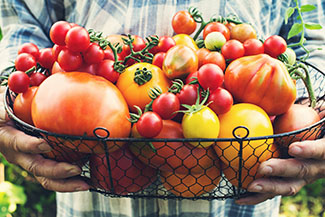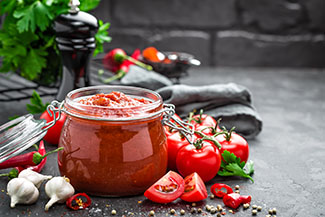Farm Fresh Tomatoes
The 'T' on Tomatoes! | Facts About Tomatoes You May Find INTERESTING
Let's talk tomatoes, the world's most popular fruit and in Arizona too! The United States Department of Agriculture's (USDA) 2017 Census of Agriculture shows Arizona hosting 61 acres of tomatoes grown in the open (The United States has 335,000+ acres), though this isn't counting the various tomato plants you might have in your backyard garden.

About 33% of Arizona's open-grown-tomato acres are in Maricopa County and another nearly 20% grown in Yavapai County. No value of sales is published for open-grown vegetables in the Census of Ag.
Also, from the 2017 Census, the United States greenhouse tomato sales were valued at $419 million. Based on value of sales, Arizona is at $14.1 million, which makes our state the sixth highest producer in the U.S. behind California, Texas, Ohio, New York, and Minnesota. Bet you didn't realize that!
From USDA's annual estimating program, U.S. open-field tomato production in 2017 was dominated by California, which grew 90% of the total production. The U.S. open-field tomato production totaled 246 million cwt (~12.3 million Tons) and was valued at $1.68 Billion. This includes both fresh and processed tomatoes. Arizona is not in the annual estimating program.
Fun Facts About #Tomatoes:
We can't leave you hanging on the vine without sharing some of our favorite facts about tomatoes!
- Arizona ranks 6th in U.S. tomato production with much of the production under greenhouse production.
- The plants typically grow to 3 to10 ft in height and have a weak stem that often sprawls over the ground and vines over other plants. It is a perennial in its native habitat, although often grown outdoors in temperate climates as an annual.
- An average common tomato weighs approximately 4 ounces. They come in yellow, pink, purple, black and even white colors with 7,500 to 10,000 varieties worldwide.
- Tomatoes are considered the world's most popular fruit with annual production of 60 to 125 million tons worldwide helping them remain the most demanded fruit in the world. Second spot goes to bananas and third to apples, followed by oranges and watermelons.
- Types of tomatoes include slicing (globe) tomatoes used in processing and for fresh eating. Beefsteak tomatoes are large, often used for sandwiches. Oxheart tomatoes vary in size and are shaped like large strawberries. Plum tomatoes (including pear tomatoes), are usually oblong, and used in tomato sauce and paste. Cherry tomatoes are small round, often sweet and eaten whole in salads. Campari tomatoes are sweet and juicy of small to medium size. Plus, the tomato is a member of the nightshade family of plants, which also includes eggplant, goji berries, potatoes, and chili peppers.

- Found at Walt Disney World Resort, Florida the largest single tomato plant in the world covers an area of 56.73 square meters. That's bigger than an Olympic-size swimming pool!
- Tomatoes are also an excellent source for vitamin C, biotin, molybdenum, and vitamin K. They are also a very good source of copper, potassium, manganese, dietary fiber, vitamin A (in the form of beta-carotene), vitamin B6, folate, niacin, vitamin E, and phosphorus.
- Tomatoes are rich in lycopene, an antioxidant that is good for the heart and effective against certain cancers. Cooked tomatoes are actually better for you than raw ones, as more beneficial chemicals are released.
- The tomato is eaten in many ways, raw like a fruit, as an ingredient in many dishes, sauces, salsas, salads, processed into ketchup or tomato soup. Tomato juice is made as a drink and used in cocktails like a Bloody Mary.
- Scientifically speaking, tomatoes are a fruit. True fruits are developed from the ovary in the base of the flower and contain the seeds of the plant.
- In 1887, U.S. tariff laws imposed a duty on vegetables, but not on fruits. This meant the status of tomatoes became a matter of legal importance. The U.S. Supreme Court ruled in the case of Nix versus Hedden that tomatoes were to be considered vegetables based on the popular definition that classifies vegetables by use, where they are usually served with dinner and not as a dessert. However, the courts did not reclassify the tomato botanically, it is still a fruit.
- 600,000 tomato seeds traveled to the International Space Station and back before being grown in school classrooms all over Canada as part of the 'Tomatosphere I, II, III and IV' experiments.
- Historians say tomatoes originally came from Peru, where their Aztec name translated to pump thing with a navel.
- The first tomatoes in Europe may have originally been yellow.
 Tomatoes are very popular in Mediterranean cuisines such a Italian. They are an important ingredient in pizza and pasta sauces.
Tomatoes are very popular in Mediterranean cuisines such a Italian. They are an important ingredient in pizza and pasta sauces.- China is the number one producer of tomatoes around the world. The U.S. is second.
- Tomatoes are the state vegetable of New Jersey. But they are the official state fruit of Ohio and tomato juice is the official beverage of Ohio. However, Arkansas took both sides by stating the South Arkansas Vine Ripe Pink Tomato is the state fruit and state vegetable, due to its culinary and botanical classification.
- La Tomatina tomato fight in Buñol near Valencia, Spain happens every year on the last Wednesday in August though the partying starts earlier in the week. The highlight of the festival is the tomato fight which takes place between 11 am and 1 pm on that day. About 242,500 pounds of tomatoes are pelted at everything that moves. The event has become one of the highlights on Spain's summer festivals calendar with thousands of people flocking to this little Valencian town for this chaotic event. And, after the La Tomatina, the village cobblestone streets are pristine due to the acidity of the tomatoes disinfecting and cleaning the surfaces, according to Wikipedia.
- Did you know Heinz Tomato Ketchup has a speed limit? If the yummy sauce pours at more than 0.028mph when it's in the Heinz Tomato Ketchup factory, it's considered too runny and rejected!
- According to the History Channels, tomatoes were put "on trial" on June 28, 1820, in Salem, New Jersey. In front of a courthouse, Robert Johnson ate a horde of tomatoes in order to prove they weren't poisonous. The crowd waited for him to die. He didn't.
- And, in Arizona we grow lots of tomatoes from backyard gardens to large greenhouse production in Willcox with Naturesweet Tomatoes Farm.
Want some tomato-based recipes or looking to learn how to grow your own tomatoes in Arizona's climate?
Go to fillyourplate.org, Arizona Farm Bureau's website full of blog stories about health and nutrition and gardening. Most of our recipes are provided by Arizona's own farm and ranch families.
PODCAST: Outdoor Living Hour! Talking Tomatoes With The Arizona Farm Bureau
Julie of The Arizona Farm Bureau and The Arizona Department Of Agriculture Director Mark Killian discuss growing tomatoes in Arizona. Why they are designated as a fruit, nutritional value and how to grow your own.
Content Provided By: Julie Murphree, Arizona Farm Bureau Outreach Director
